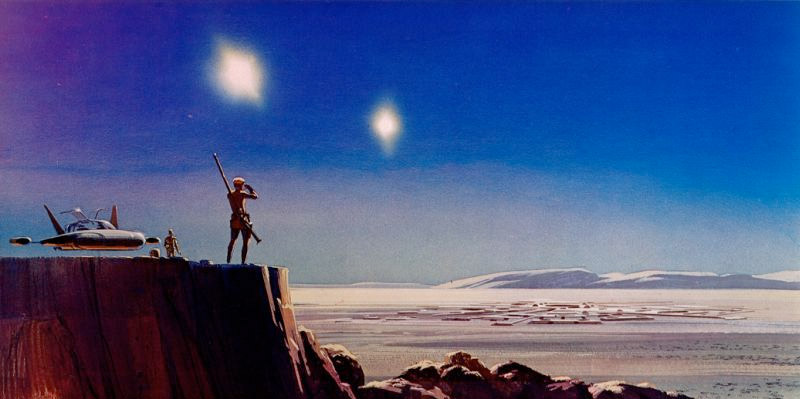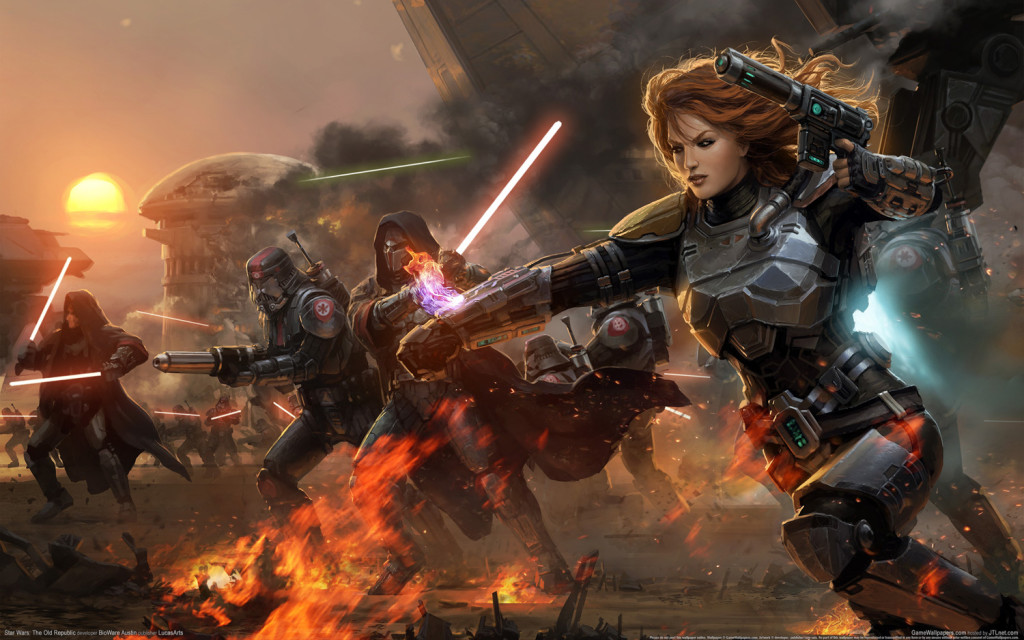Last year, in anticipation of the upcoming Star Wars film, I invited anyone who wanted to send in their own Star Wars script to do so. I would review the Top 5, and if one was really awesome, who knows, Disney might see it and get the writer involved in a future installment of the series. I received 20 Star Wars scripts in total. This week, I will review the best 5. Let’s hope we find a winner!
Genre: Sci-Fi fantasy
Premise: (from writer): 1000 years in the future of the Star Wars universe, a young female fugitive from Tatooine and the last Sith Lord must travel to the abandoned city world of Coruscant to retrieve the location of an ancient planet-destroying superweapon: the Galaxy’s only hope of overthrowing the totalitarian rule of a sinister New Jedi Order.
About: The mysterious Ellen Starkweather seems to get hyped a lot in the comments section, yet no one knows where she comes from or where she gets her fans. Can Scriptshadow readers solve the mystery? I reviewed one of Ellen’s scripts awhile back. Let’s see what she has in store for us today…
Writer: Ellen Starkweather
Details: 157 pages!
As you’d expect, I have some MAJOR opinions about Star Wars, way too many to get in to here. But one of my strongest opinions is that in the two best Star Wars films, A New Hope and The Empire Strikes Back, the films are all about urgency. They move quickly because they’re both chase films, with Darth Vader always on our heroes’ tail. The problem with the prequels was that they ditched this formula in favor of slow introspective mythology lessons. It wasn’t pretty.
So when I opened this up and saw 158 pages, my head sunk. 158 pages?? That pretty much ensured there would be zero urgency. And it’s not the only Star Wars script of the bunch with that kind of page count. There’s another one that’s 150 pages! I’m telling you, the Star Wars formula that works best is one that keeps things moving. BUT I’ll gladly eat my shorts if Ellen Starkweather can prove me wrong. Let’s see if this 160 page epic changes my opinion…
It is 1000 years after the end of Episode 6, but you might not have guessed it, since we start right back on our favorite little dusty planet, Tantooine! It’s here where we meet a couple of our Jedis, Master Mahrel-Dee Goodweather, a middle-aged woman, and Temlin, a 16 year old girl who’s just starting to realize her Jedi powers. Neither of these two know each other yet. But they will. Oh yes, they will….
So in this episode, it’s kind of like Jerry Seinfeld’s Bizarro World, as the universe has been flipped. The Republic is firmly in control, but they’ve become such a dictatorship that, without even knowing it, they’re now the bad guys. Joining the Dark Side is the new hip “rebellious” thing to do. And that’s what Temlin and her land-speeder racing buddies are into.
Eventually, Master Mahrel-Dee goes looking for this new Jedi girl, possibly for training, but Temlin is able to get away and go to Yoda’s old stomping grounds (or mushing grounds?), Dagobah, where she’s been sent to meet someone important. It’s there where she finds a dark-cloaked 900 year old man who happens to be a Jedi himself! Or a Sith Lord, depending on your perspective.
It doesn’t take us too long to figure out that this 900 year old guy is Luke Skywalker (yes, you read that correctly), and Luke wants to bring Temlin to Coruscant to look for some old super-weapon plans (if you’re thinking these plans have something to do with Death Star 3.0, you’d be correct). She’s not so sure, but she doesn’t have many other options (it’s not like there’s a bar on Dagobah to think things over), so she says ‘why not.’
Meanwhile, Master Mahrel wants to get her hands on Temlin because Jedi chosen-ones are at a premium. So, about a hundred pages into the script, she starts chasing the two through the galaxy and is finally able to nab them. It’s then that Luke and Mahrel get into a lightsaber duel and she kills Luke the exact same way Vader killed Obi-Wan!
But a ship collision follows and Mahrel is burned over 80% of her body. She wakes up three years later (yes, three years), and is now wearing (yup, you guessed it) a white female Vader suit. Oh, and while she was asleep, a new Death Star was built! And hence we get another final-act run at our favorite robot moon, where it is once again, sadly, destroyed.
Okay, where do I start here! Let’s start with the good. The page count here is way too long. But at least the script was easy to read. Most paragraphs were two lines or less and the dialogue moved along quickly. While I wasn’t always thrilled with the direction the story took, Starkweather was usually able to move us through each sequence quickly, whether it be a speeder race on the now overrun-with-jungles Coruscant, Temlin trying to snatch Boba Fett’s old laser gun from the Sarlac Pit or the occasional space battle.
Old Weapons has one major problem though. It uses the old films as its crutch. The entire movie is a mish-mash of the plots from the original trilogy. We have our hero growing up on Tantooine, her family dying, having to go to the Cantina in Mos Eisley, going to Dagobah where someone’s been hiding for 900 years, getting captured on the bad guy’s ship, to the older wiser Jedi getting struck down by another Jedi, to a Jedi getting burned to death and needing to live inside a life-support machine, to a Death Star being made and having to be destroyed. There was so darn little originality in this script that, if I’m being honest, it was hard to take it seriously.
It all boils down to the script being too “fan boy.” What I mean by that is the writer clearly loves the original films so much that they can’t think beyond them, and therefore every decision and choice is in service to those movies somehow. Why, for instance, do we have characters trying to get Boba Fett’s gun in the Sarlac Pitt if it has nothing to do with the story other than it’s cool to bring up Boba Fett?
Then there’s Luke Skywalker. Luke Skywalker’s been alive for 900 years? I mean, I guess he has the force in him, and we’ve established that allows beings to do things they otherwise wouldn’t be able to do, but this just rang false (and somewhat goofy) to me.
I wanted to see something NEW brought to the table. I wanted a different story to experience, not a rehash of everything I’ve already seen. There are hints of that here. Obviously, our main young Jedi is a girl. The new “Darth Vader” is a girl. But I don’t think you can just change the sex and everything be new and different.
On top of all this were some… curious choices. When we meet Jedi Master Mahrel-Dee, it’s insinuated that she just got out of a three-way with two younger Jedis. Also, 16 year old Temlin is in a relationship with another 15 year old girl, one who she plays sex games with (it’s implied) where one of them dresses up like “General Master Solo.” Then later, one of our characters is a suicide bomber who blows up a bunch of people.
Choices like this really worried me because the tone of Star Wars is a clear one. It’s light fun entertainment. I don’t know why we’re implying sex on any level, much less playing dress up in a sexualized lesbian teenage relationship or having three-ways. And suicide bombers, while maybe a little easier to buy in this universe, are too complicated an idea for the target audience (young children) to grasp.
Tone is something I continue to see amateurs struggle with. They often throw anything they think of into their stories without considering how it fits in with the bigger picture. It’s like they take the stance, “If I think of it, then it’s tonally consistent.” That’s not how it works. I’m not going to have Eve imply she wants to give Wall-E a blow-job just like I’m not implying three-ways in Star Wars.
Then there are just the geeky things that I personally didn’t agree with. I’m not sure you mess with the opening crawl (having the letters turn blood red and say everything you just read was propaganda). I don’t think you want to talk about midi-chlorians, as it was widely agreed that this was a huge misstep for the franchise. Coruscant being run by cannibals who strap human skeletons to the front of their ships felt exactly like the Firefly villains, to the extent that it was almost a direct ripoff.
I think that’s my biggest beef here. There was no originality in Old Weapons. It was all rehashing storylines and characters we already knew. For Star Wars to grow (and for any script to grow), it needs to explore new ideas and invent its own story. I kept waiting for that to happen with Old Weapons but it never did. ☹
Screenplay link: Star Wars: Old Weapons
[ ] what the hell did I just read?
[x] wasn’t for me
[ ] worth the read
[ ] impressive
[ ] genius
What I learned: “Writing light” is when you write very sparse paragraphs (one or two lines tops). “Writing heavy” is the opposite (Thick paragraphs of 4-5 lines). When you “write heavy,” the page count tends to be lower, since your lines aren’t spread out as much. “Writing light” creates the opposite effect. The excess carriage returns take up more space and can easily add 10-20 pages to your script. So there’s this debate whether one should “write heavy” to keep the page length down, even though it means a harder read, or “write light,” which jacks up the page count, but is much easier for the reader to get through. Here, Ellen obviously took the “writing light” approach and added a good 20 pages as a result. I admit it was easier to read than if this was 140 pages written “heavy,” but the reality is, 160 pages is just too damn many, period. My advice is: this is screenwriting. You have to do both. You have to write light with a heavy writer’s content. Let me give you an example:
The robust trees and their exposed roots snake through the yard like curious animals, adding a deep unexpected texture to the front of the house, the kind of anomaly that screams “unnatural.”
You can just as easily write…
The trees’ gnarly exposed roots snake unnaturally through the front yard.
What I learned 2: If there is a large LONE time-jump forward in the second or third act of your script, there is probably something very wrong with your story (and one of the biggest tell-tale signs that you’re reading an amateur). Large time jumps happening once your story gets going almost NEVER work unless you’re established a time-jumping rhythm throughout your script (and this is one of many time jumps, such as you’ll see in a movie like Braveheart).



